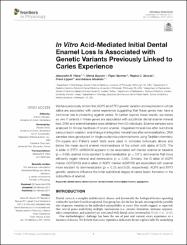| dc.contributor.author | Vieira, Alexandre R. | |
| dc.contributor.author | Bayram, Merve | |
| dc.contributor.author | Seymen, Figen | |
| dc.contributor.author | Sencak, Regina C. | |
| dc.contributor.author | Lippert, Frank | |
| dc.contributor.author | Modesto, Adriana | |
| dc.date.accessioned | 2020-07-14T13:26:16Z | |
| dc.date.available | 2020-07-14T13:26:16Z | |
| dc.date.issued | 2017 | en_US |
| dc.identifier.citation | Vieira, A. R., Bayram, M., Seymen, F., Sencak, R. C., Lippert, F. ve Modesto, A. (2017). In vitro acid-mediated initial dental enamel loss is associated with genetic variants previously linked to caries experience. Frontiers in Physiology, 8. https://dx.doi.org/10.3389/fphys.2017.00104 | en_US |
| dc.identifier.issn | 1664-042X | |
| dc.identifier.uri | https://dx.doi.org/10.3389/fphys.2017.00104 | |
| dc.identifier.uri | https://hdl.handle.net/20.500.12511/5497 | |
| dc.description.abstract | We have previously shown that AQP5 and BTF3 genetic variation and expression in whole saliva are associated with caries experience suggesting that these genes may have a functional role in protecting against caries. To further explore these results, we tested ex vivo if variants in these genes are associated with subclinical dental enamel mineral loss. DNA and enamel samples were obtained from 53 individuals. Enamel samples were analyzed for Knoop hardness of sound enamel, integrated mineral loss after subclinical carious lesion creation, and change in integrated mineral loss after remineralization. DNA samples were genotyped for single nucleotide polymorphisms using TaqMan chemistry. Chi-square and Fisher's exact tests were used to compare individuals above and below the mean sound enamel microhardness of the cohort with alpha of 0.05. The A allele of BTF3 rs6862039 appears to be associated with harder enamel at baseline (p = 0.09), enamel more resistant to demineralization (p = 0.01), and enamel that more efficiently regain mineral and remineralize (p = 0.04). Similarly, the G allele of AQP5 marker rs3759129 and A allele of AQP5 marker rs296763 are associated with enamel more resistant to demineralization (p = 0.03 and 0.05, respectively). AQP5 and BTF3 genetic variations influence the initial subclinical stages of caries lesion formation in the subsurface of enamel. | en_US |
| dc.description.sponsorship | United States Department of Health & Human Services National Institutes of Health (NIH) - USA | en_US |
| dc.language.iso | eng | en_US |
| dc.publisher | Frontiers Media S.A. | en_US |
| dc.rights | info:eu-repo/semantics/openAccess | en_US |
| dc.rights | Attribution 4.0 International | * |
| dc.rights.uri | https://creativecommons.org/licenses/by/4.0/ | * |
| dc.subject | Dental Caries | en_US |
| dc.subject | Dental Enamel | en_US |
| dc.subject | Dental Erosion | en_US |
| dc.subject | Transcription Factors | en_US |
| dc.subject | Aquaporins | en_US |
| dc.title | In vitro acid-mediated initial dental enamel loss is associated with genetic variants previously linked to caries experience | en_US |
| dc.type | article | en_US |
| dc.relation.ispartof | Frontiers in Physiology | en_US |
| dc.department | İstanbul Medipol Üniversitesi, Diş Hekimliği Fakültesi, Çocuk Diş Hekimliği Ana Bilim Dalı | en_US |
| dc.authorid | 0000-0002-8440-367X | en_US |
| dc.identifier.volume | 8 | en_US |
| dc.relation.publicationcategory | Makale - Uluslararası Hakemli Dergi - Kurum Öğretim Elemanı | en_US |
| dc.identifier.doi | 10.3389/fphys.2017.00104 | en_US |
| dc.identifier.wosquality | Q1 | en_US |
| dc.identifier.scopusquality | Q1 | en_US |




















